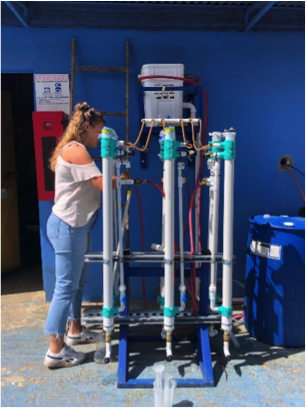Study of arsenic oxidising bacteria in water in Costa Rica
The presence of arsenic in drinking water is toxic and case health problems, the World Health Organization (WHO) set the limit of arsenic concentration to < 10 µg/L. Currently, a chemical method is used for the removal of arsenic to get an arsenic level below the guidelines of 10 µg/L. Since this chemical method can affect the environment and is expensive, a biological method is introduced.
Two forms of arsenic are found in groundwater; As(III) and As(V). As(V) is more effectively adsorbed onto flocculating hydrous ferric oxides than As(III), leading to an increased removal capacity. For an optimal removal of arsenic from drinking water, first As(III) has to oxidize to As(V). A biological pilot plant is built at La Rueda, Costa Rica, to investigate this oxidation. The pilot system was fed with aerated groundwater.
The aim of my study was to investigate whether arsenic oxidising bacteria (AsOB) are present in the pilot system and whether they case the oxidation of As(III) to As(V). For this purpose As(III) oxidation was monitored for 34 days in a start-up phase. The pilot system contains of sand and pumice columns, to compare the two filter media and link them to the biomass growth.
The project is done at TEC, Cartago. During this time I stayed at a family’s house 20 minutes’ walk from the university. The whole experience of going abroad for my thesis was unforgettable. By going abroad for my bachelor thesis I had the wonderful opportunity to further develop and challenge myself. Finally after four years of studying, I could really put the theory into practice through research. It was my first time working on a project in a different country and during my time at the TEC I learned a lot. Prof. Dr. Luuk Rietveld brought me in contact with Dr. Luis Guillermo Romero Esquivel, who guide me through the period of time.
Of course, during the study there were complications. Multiple times when I went to La Rueda the pump was not on which caused difficulties during my research. Besides, going there by bus and taking all the material with me to the field was a hard job. In the beginning was hard for me to adjust to the situation and deal with these issues, but after a while I learned to control the situation and found solutions to improve the circumstances.
Next to writing my thesis I visited several places in Costa Rica, such as Tamarindo, Santa Teresa, Puerto Viejo and Monteverde. It is amazing that during this project, I could visit beautiful cities and enjoy the whole experience.
Desiree Vermeulen
